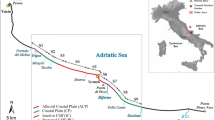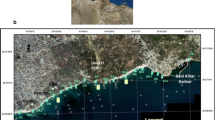Abstract
Aerial photographs taken in the 1963 and 2001 and bathymetric charts, in conjunction with coastal processes are analyzed to assess changes in rate of shoreline position, seabed level, and seabed grain sizes along the Tabarka–Berkoukech beach at the north-western Tunisian coastline. The littoral cell of this beach, 12-km-long, is bounded by pronounced embayments and rocky headlands separated by sandy stretches. Although not yet very much undeveloped, this littoral is still experienced degradation and modification, especially along its shoreline, with significant coastal erosion at some places. Results obtained from analysis of shoreline position indicate that El Morjene Beach is experienced a landward retreat of more than −62 m, at a maximum rate of −1.64 m/year, whereas the El corniche beach is advanced about 16–144 m, at an average rate of 0.42 m–3.78 m/year. This beach accretion has been formed on the updrift side of the Tabarka port constructed between 1966 and 1970. Comparison of bottom contours deduced from bathymetric charts surveyed in 1881 and 1996 off the coastline between Tabarka Port and El Morjene Beach identifies erosional areas (sediment source) and accretionary zones (sediment sink). Erosion (0.87–4.35 cm/year) occurs between El kebir River Mouth and El Morjene beach, whereas accretion exists in the zone down wind of the port ranges between 0.87 and 5.21 cm/year. Morphological analyses of the shoreline and the seabed of the study nearshore area indicate that shoreline retreat corresponds to areas of seabed scour (sediment source) while shoreline accretion is associated with areas of seabed deposition (sediment sink). Furthermore, simulation of wave propagation using STWAVE model combined with grain size distributions of the seabed shows that fine sands are much dominated in depositional areas with low wave energy, whereas coarser sands in erosive zones with high wave energy. The results obtained suggest that the change of seabed morphology, wave height pattern and grain size sediment have a great influence on the modification of shoreline morphology and dynamics.







Similar content being viewed by others
References
BCEOM/STUDI (1981) Étude de l’extension des ports de pêche de Tabarka et Kelibia, problèmes de transit littoral et de sédimentation
Bender CJ, Dean RG (2003) Wave transformation by two-dimensional bathymetric anomalies with sloped transitions. Coastal Eng 50:61–84
Crowell M, Douglas BC, Leatherman SP (1997) On forecasting future U.S. shoreline positions: a test of algorithms. J Coast Res13 4:1245–1255
Folk RL, Ward WC (1957) Brazos River bar: a study of significante of grain size parameters. J Sediment Petrol 27:3–4
Frihy OE, Dewidar KM (2003) Patterns of erosion/sedimentation, heavy mineral concentration and grain size to interpret boundaries of littoral sub-cells of the Nile Delta, Egypt. Marine Geol 199:27–43
Gottis C (1953) Note sur l’âge des dunes d’Ouchtata, DRE
Halouani N, Sabatier F, Gueddari M, Fleury J (2007) Evolution du trait de côte de Tabarka-Bouterfess, Nord-Ouest de la Tunisie. Méditerranée 108:131–137
HP Hidrothecnica Portugesa (1995) Etude générale pour la protection du littoral tunisien. Rapport I-II-III-IV et V, Ministère de l’Equipement Tunisien
Jlassi F (1993) Risques naturels et problèmes d’environnement à Tabarka et ses environs. Mémoire C.A.R. Fac. Sc. Hum, Tunis, p 170
Maa JPY, Hsu TW, Tsai CH, Juang WJ (2000) Comparison of wave refraction and diffraction models. J. Coastal Res16(4):1073–1082
Macdonald N.J, O’Conner BA (1996) Change in wave impact on the Flemish coast due to increased mean sea level
Niedoroda AW, Swift DJP, Hopkins TS (1985) The shoreface. In: Davis RA (ed) Coastal sedimentary environments. Springer, New York, pp 533–624
Oueslati A (1994) Les côtes de la Tunisie: Géomorphologie et environnement et aptitudes à l’aménagement, série Géographie, vol XXXIV. Université de Tunis, 387 p
Oueslati A (2001) Les dunes littorales en Tunisie: journ. Inf et sens sur les techniques de réhabilitation des dunes bordières; APAL, 4 p
Oueslati A (2004) Littoral et aménagement en Tunisie: des enseignements de l’expérience du vingtième siècle et de l’approche géoarchéologique à l’enquête prospective, 534 p
Paskoff R (1985) Géographie de l’environnement : problème de l’utilisation des ressources et d’adaptation aux contraintes des milieux naturels, exemple tunisien. Tunis, 227 p
Paskoff R (1992) Eroding Tunisian beaches: causes and mitigation. Bollettino di Oceanologia teorica ed applicata 10:85–91
Resio DT (1987) Shallow-water waves I: Theory. J Waterw Port Coast Ocean Eng 113(3):264–281
Resio DT (1988a) Shallow-water waves. II: Data comparisons. J Waterw Port Coast Ocean Eng 114(1):50–65
Resio DT (1988b) A steady-state wave model for coastal applications. In: Proceeding of the 21st international conference in coastal engineering. ASCE, pp 929–940
Saadaoui M (1995) Erosion et transport solide en Tunisie, mesure et prévision du transport solide dans les basins versants et de l’envasement dans les retenues de barrages. Ministère de l’agriculture, Direction de Ressources en Eau, rapport
Sly PG, Thomas RL, Pelletier BR (1983) Interpretation of moment measures derived from waterlain sediments. Sedimentology 30: 219–233
Smith JM, Militello A, Smith SJ (1998) “Modeling waves at Ponce de Leon Inlet, Florida.” In: Proc. 5th international workshop on wave hindcasting and forecasting. Environment Canada, Downsview, Ontario, pp 201–214
Smith JM, Resio DT, Zundel AK (1999) STWAVE: Steady-state spectral wave model. Instruction Report CHL-99-March 1999, U.S. Army Engineer Waterways Experiment Station, Vicksburg MS.10
Smith JM, Sherlock AR, Resio DT (2001) STWAVE: Steady-State Spectral Wave Model, user’s manual for STWAVE, Version 3.0. USACE, Engineer Research and Development Center, Technical Report ERDC/CHL SR-01-1, Vicksburg, MS 80
Swift DJP (1976) Coastal sedimentation. In: Stanley DJ, Swift DJP (eds) Marine sediment transport and environmental management. Wiley, New York, pp 255–310
Thieler ER, Himmelstoss EA, Zichichi JL, Miller TL (2005) Digital Shoreline Analysis System (DSAS) version 3.0; An Arc GIS extension for calculating shoreline change. U.S. Geological Survey Open-File Report 2005-1304
Acknowledgments
The authors are very grateful to Dr Omran Frihy for valuable suggestions, support and guidance. We would also like to thank Pr Habib Belaouni for improving the English and to Pr Antonio trigo texteira for providing the STWAVE MODEL.
Author information
Authors and Affiliations
Corresponding author
Rights and permissions
About this article
Cite this article
Halouani, N., Fathallah, S. & Gueddari, M. Beach and nearshore morphodynamic changes of the Tabarka coast, Northwest of Tunisia. Environ Earth Sci 66, 1059–1069 (2012). https://doi.org/10.1007/s12665-011-1312-5
Received:
Accepted:
Published:
Issue Date:
DOI: https://doi.org/10.1007/s12665-011-1312-5




